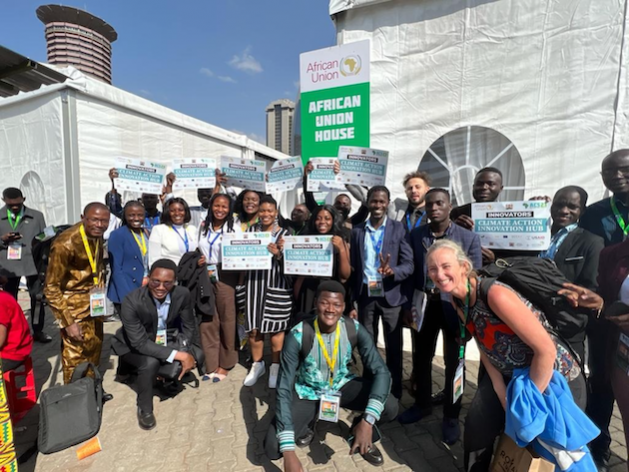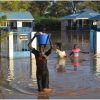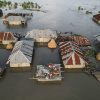[ad_1]
Creator and Web page info
- This web page: https://www.globalissues.org/article/805/cop20-lima-climate-conference.
- To print all info (e.g. expanded aspect notes, exhibits various hyperlinks), use the print model:
On this web page:
Introduction
 December 1 – 14, 2014, Lima, Peru was the venue for the twentieth annual United Nations Local weather Change Convention, often known as the twentieth Convention of the Events — or COP 20.
December 1 – 14, 2014, Lima, Peru was the venue for the twentieth annual United Nations Local weather Change Convention, often known as the twentieth Convention of the Events — or COP 20.
The aim of this convention was to create a common settlement on local weather change motion and start the method of financing mitigation.
Assembly final result
The assembly ended with all nations agreeing to chop again greenhouse fuel emissions. Often known as the Lima Accord, this treaty shouldn’t be legally binding and nations shouldn’t have to specify how a lot they are going to in the reduction of, as an alternative agreeing to report their plans again by March 2015.
Whereas for a lot of it gave the impression of a profitable final result, others had been dissatisfied, similar to poor nations struggling to rebuild from present impacts of local weather change who had been alarmed on the disappearance of loss and injury commitments from the ultimate textual content which has been a part of the dialogue for years.
The worldwide local weather motion, 350.org, summarized the disappointments and hopeful facets of the assembly final result, noting
- The brand new settlement doesn’t replicate the urgency of the local weather disaster
- Some good agreements – however no measures to make sure implementation
- Least developed and susceptible nations neglected within the chilly
- Divestment (from fossil gas reliance) is extra vital than ever
- World momentum for actual options is stronger than ever and can carry on going.
In attempting to place a constructive spin on the general disappointment they felt, they concluded, Ultimately, a world local weather treaty is only one software to fight local weather change. Actual change goes to proceed to come back from the grassroots. The UN Local weather Talks proceed to be a spot the place the world’s nations comes collectively to debate this disaster and individuals are placing in monumental efforts to verify Paris [the next global meeting] received’t be like Copenhagen
which was filled with disappointments regardless of massive guarantees.
Samantha Smith, Chief of WWF’s World Local weather and Vitality Initiative, was fairly scathing of the assembly final result saying that political expediency received over scientific urgency
. She additionally famous that Developed nation governments couldn’t even handle to elucidate how they are going to ship the long-promised US$100 billion per 12 months in local weather finance by 2020. In a transfer that seemingly dismissed the plight of essentially the most susceptible nations, they fully eliminated any significant language about ‘loss and injury’.
Mainstream media reporting
As with virtually each earlier assembly (with occasional exceptions), mainstream media reporting was very poor given the significance of this international subject. The place the assembly was reported it was usually in the direction of the top, and simply sound chew kind summaries saying all nations agreed to emission cuts and that this was a significant enchancment.
Whereas the treaty continued to say it honors the long-standing widespread however differentiated duties
the mainstream media reporting (as in most years) has usually failed to supply clarification and context of this precept that has been an vital a part of these talks for over 2 many years; that poor and growing nations shouldn’t bear the identical duties because the developed ones (as a result of they aren’t the reason for the anthropogenic carbon emissions over the earlier many years which have led to this, which is detailed way more on this website’s web page on local weather justice).
A touch in the direction of this precept could have been introduced as a viewpoint of China or India, given the impression they’re being obstacles, somewhat then explaining this precept in additional context.
That was simply one of many points skirted over or omitted from widespread reporting. Others included points on financing, know-how assist for poorer nations, and many others. Behind the scenes, for many years, wealthy nations have stalled on this stuff or actively averted attempting to share know-how and many others, which is barely reported.
Yearly, this criticism is fabricated from mainstream reporting, so with out following these negotiations annually, it may be simple to come back away with the impression that this assembly had a constructive final result.
However as this dialogue hosted by Democracy Now! exhibits, there have been a lot of vital problems with rivalry:
In context: widespread however differentiated duties
A few years in the past all nations agreed that local weather change was largely the results of actions from at this time’s industrialized nations, as carbon dioxide — the principle greenhouse fuel — stays within the ambiance for many years. But, the poorest would find yourself struggling essentially the most for an issue they largely didn’t trigger. The approaches to mitigation (emissions discount) would due to this fact be totally different for these teams of nations — the widespread however differentiated duties precept.
It’s on this context that the dialogue for loss and injury has come about. And it’s one thing that wealthy nations are eager to eliminate .
The years of resistance on this subject (and lots of others) means every time it’s mentioned once more the reactions appear to get much more hostile. Mixed with the dearth of detailed context within the mainstream media protection of this side, it then turns into simpler every time to see culprits as China and India given their monumental greenhouse emissions in recent times, in comparison with the far larger quantity by the industrialized nations over the longer interval. See this website’s part on local weather justice for extra detailed background.
And as this website has stated for years on the local weather justice web page, the wealthy nations are delaying any significant motion till it’s finally — and disproportionately — paid for the by the growing nations. New Delhi based mostly Nitin Sethi, affiliate editor at Enterprise Customary, interviewed within the earlier talked about video says the identical factor, however extra frankly:
There is no such thing as a motion that’s going to occur between now and 2020. All of that was to be achieved by the developed nations. They [rich nations] mainly have simply stated at Lima that
we’re not going to do any greater than what we’re doing up to now, and the burden can shift onto the post-2020 period, the place different growing nations need to share it.So, to me, it signifies actually negotiation in dangerous religion.
Extra info
Because the convention continues to be underway as this web page is written, extra info might be added right here after the occasion is over.
For extra concerning the points from different organizations, listed below are some beginning factors:
Information tales from IPS
Beneath is a listing of tales from Inter Press Service associated to the Lima local weather convention and its aftermath.
-
Wrecked by Local weather Change, Farmers in Kashmir Shift to Lavender Cultivation
– Inter Press Service

BIJBEHARA, INDIA, Sep 29 (IPS) – Creating resilience is essential to local weather change justice. In Bijbehara, a hamlet south of Kashmir’s capital, Srinagar, lavender farming has meant farmers grappling with unseasonal rains, extended warmth waves, and extreme water shortage have discovered a brand new technique of survival.
Mohammad Subhan Dar diligently tends to some shiny purple vegetation on a four-acre farm in Bijbehara, a hamlet south of Kashmir’s capital, Srinagar. As you draw nearer, you’ll be mesmerized by the sight of sprawling lavender fields, the place about 10 to fifteen farmers, together with Dar, put together for a promising harvest. -
Wished: A New Native Oversight Construction to Obtain SDGS, Local weather Motion & Biodiversity Preservation
– Inter Press Service

KATHMANDU, Nepal, Sep 29 (IPS) – The hyperlinks between Agenda 2030 and SDGs, together with local weather motion and biodiversity preservation are clear and easy. But, leveraging them, and bringing them to collectively in a unified framework, stays extraordinarily difficult.
-
Peru Faces Problem of Local weather Change-Pushed Inside Migration
– Inter Press Service

LIMA, Sep 28 (IPS) – Almost 700,000 folks have migrated internally in Peru because of the results of local weather change. This mass displacement is a transparent downside on this South American nation, probably the most susceptible to the worldwide local weather disaster because of its biodiversity, geography and 28 several types of climates.
-
Stopping warfare, stepping up local weather motion: Francis wraps up UNGA78
– UN Information

Ending the warfare in Ukraine, selling local weather motion and ramping up efforts to realize the Sustainable Growth Targets (SDGs) topped the agenda of the Excessive Stage Week of the UN Basic Meeting, the person on the helm of the worldwide platform for dialogue stated on Thursday.
-
At UN, Pacific Island leaders sound alarm on local weather disaster, name for pressing motion
– UN Information

Leaders from Pacific island nations collectively rang the alarm on the relentless march of local weather change, marked by rising sea ranges, excessive climate occasions and coastal erosion, wreaking havoc and threatening the very existence of their homelands.
-
‘Humanity has opened the gates to hell’ warns Guterres as local weather coalition calls for motion
– UN Information

“Horrendous warmth is having horrendous results”, the UN chief declared on Wednesday, as a broad international coalition of “movers and doers” politicians, enterprise and civil society gathered in New York for the primary ever Local weather Ambition Summit.
-
‘No nonsense’ Local weather Ambition Summit: What it’s worthwhile to know
– UN Information

The race to guard the planet is about to speed up, as world leaders, enterprise giants, and consultants collect to attend the Local weather Ambition Summit on Wednesday.
-
Youth Rally for Peace By Local weather Justice on the UN
– Inter Press Service

UNITED NATIONS, Sep 15 (IPS) – “What do we would like? Local weather justice! When do we would like it? Now!” youth chanted in an unusually energetic convention on the United Nations Headquarters.
-
Local weather inaction places lives on the road: WMO
– UN Information
-
The Africa Local weather Summit: Anti-Colonial Rhetoric Meets Inexperienced Colonialism
– Inter Press Service

OAKLAND, California, Sep 13 (IPS) – Within the wake of the current Africa Local weather Summit, which convened in Nairobi from September 4-6, 2023, the world’s consideration was drawn to the urgent challenges going through the African continent because it grapples with the devastating results of local weather change.
-
Consultants make case for tackling local weather and sustainable growth collectively
– UN Information

A brand new UN report delivers a powerful message to world leaders heading to New York for the Basic Meeting’s annual high-level week: tackling the local weather and sustainable growth crises collectively will assist speed up general progress on the 2030 Agenda.
-
Africa Finds Frequent Floor on Local weather as Nairobi Declaration Unveiled
– Inter Press Service

NAIROBI, Sep 07 (IPS) – To chill down a burning planet, Africa’s Head of State and Authorities on the inaugural Africa Local weather Summit unveiled the ‘Nairobi Declaration’ as curtains fell on the inaugural Africa Local weather Summit held in Nairobi, September 4-6, 2023, beneath the theme “Driving Inexperienced Development and Local weather Finance Options for Africa and the World.”
-
Could the Race for Local weather Justice Chief Start
– Inter Press Service

AMSTERDAM, Sep 07 (IPS) – Tremendous-charging efforts and setting a recent course for the subsequent part of local weather policymaking is what’s urgently wanted and on provide this month through the 78th UN Basic Meeting in New York, as mass warmth waves, devastating wildfires, deadly floods, and withering droughts proceed to wreak havoc throughout continents.
-
African Startups Mull Dwelling-Grown Options to Fight Local weather Change
– Inter Press Service

NAIROBI, Sep 06 (IPS) – A bunch of younger African startups made their presence recognized on the Africa Local weather Summit in Nairobi, Kenya, hoping to play a giant position in selling home-grown climate-oriented options.
-
‘Local weather breakdown’ alert as air high quality dips throughout heatwaves: UN chief
– UN Information

Amplified by wildfires and desert mud fanned by local weather change, extra frequent heatwaves are resulting in a pointy drop in air high quality and human well being, the World Meteorological Group (WMO) stated in a brand new report on Wednesday.
-
Toothless World Monetary Structure Fuelling Africas Local weather Disaster
– Inter Press Service

NAIROBI, Sep 05 (IPS) – Africa wants roughly USD 579.2 billion in adaptation finance over the interval 2020 to 2030, and but the present adaptation flows are 5 to 10 instances beneath estimated wants. As hundreds convene in Kenya’s capital, Nairobi, for the Africa Local weather Summit, the primary time the African Union has summoned its leaders to solely talk about local weather change beneath the theme ‘Driving Inexperienced Development and Local weather Finance Options for Africa and the World’, the backdrop is a rustic on the frontlines of a local weather disaster.
-
Africa’s Potential: Main Meals System Transformation and Local weather Resilience
– Inter Press Service

NAIROBI, Kenya, Sep 05 (IPS) – When a continent with 65% of the world’s arable land struggles to feed its 1.4 billion folks, we all know one thing is unsuitable. The African and international meals programs want a rethink. The pressing and urgent want to deal with a extra productive, clear, equitable meals system, poverty and the far-reaching results of local weather change requires us to forge alliances amongst various stakeholders and sectors.
-
‘I’m since you are’ – Local weather Justice By the Spirit of Ubuntu
– Inter Press Service

PORT LOUIS, Sep 04 (IPS) – The Africa Local weather Summit 2023 is predicted to begin with renewed hope. In its 60+ years of post-independence historical past, Africa has contributed round 3% of Inexperienced Home Emissions, accounts for about 2.6% of world commerce, and fewer than 3% of the world’s GDP in 2021.
-
Philippines: Indigenous data takes on local weather disaster
– UN Information

Within the mountainous province of Bukidnon within the southern Philippines, native indigenous teams are being pressured to adapt to the alarming impacts of local weather change. With UN assist, communities are making important strides, utilizing centuries-old data to forge sustainable options.
-
The Case for Local weather Justice
– Inter Press Service

JOHANNESBURG, Sep 01 (IPS) – In case you’ve by no means seen a landslide earlier than, it’s a terrifying drive of nature. Those that have discovered themselves within the thick of this phenomenon say the earth beneath your toes immediately begins to present method, the bottom cracks open, and huge plenty of soil, rocks, and particles come crashing down. It’s as if the very floor you stand on is rebelling in opposition to the altering local weather and its impression on the fragile steadiness of the atmosphere.
-
Bangladesh’s Battle In opposition to Local weather Change: A Nation at Danger
– Inter Press Service

DHAKA, Sep 01 (IPS) – Bangladesh faces one in all its most important challenges ever — local weather change. Rising sea ranges, excessive climate occasions, and altering rainfall patterns are already profoundly impacting this nation.Bangladesh, a picturesque land of rivers, lush inexperienced landscapes, and a vibrant cultural heritage, faces one in all its most important challenges ever — local weather change.
-
Africa Local weather Summit: a Important Alternative for Collective Motion on Local weather Change
– Inter Press Service

NAIROBI, Sep 01 (IPS) – As an African, I’ve seen first-hand the devastating results of local weather change. I’ve met communities displaced by floods in Malawi, Mozambique and Zimbabwe. I’ve spoken to farmers from Northern Kenya who’ve misplaced their crops to drought. These experiences have made me aware of how pressing it’s to deal with the local weather disaster.
-
African youngsters bearing the brunt of local weather change impacts
– UN Information

Youngsters in Africa are among the many most in danger from local weather change impacts however are being woefully disadvantaged of the financing crucial to assist them adapt, survive and reply to the disaster, the UN Youngsters’s Fund (UNICEF) stated in a brand new report on Friday.
-
UN skilled urges worldwide assist for The Bahamas amid local weather disaster
– UN Information

A UN-appointed human rights skilled on Friday urged the worldwide neighborhood to extend help to The Bahamas and different small island States that face elevated threats from pure disasters ensuing from local weather change.
-
Local weather Justice Delayed, Is Justice Denied
– Inter Press Service

BULAWAYO, ZIMBABWE, Aug 31 (IPS) – Local weather justice is not only about survival but additionally about profit sharing, lowering inequality and enabling a greater society that thrives – Yamide Dagnet, Local weather Justice Director at Open Society FoundationsThe failure to sort out the local weather change disaster is an injustice to the hundreds of thousands who’ve misplaced lives and livelihoods via floods, excessive climate, and wildfires, pointing to the urgency of adaptation and mitigation finance, consultants say.
-
Africa Local weather Summit: Time for Tangible, Impactful, & Accountable Local weather Motion
– Inter Press Service

OAKLAND, California, Aug 29 (IPS) – African leaders, public officers, and private-sector executives will converge in Nairobi, September 4-6, on the Africa Local weather Summit (ACS) – coinciding with the UN Africa Local weather Week (ACW). Lately, Africa has been the poster baby for local weather options, with carbon credit score and offset tasks gaining recognition amongst the private and non-private sectors alike.
-
Constructing Agricultural Resilience in a Altering Local weather: Methods to Safeguard Crop Manufacturing Amidst Excessive Climate Occasions
– Inter Press Service

URBANA, Illinois, USA, Aug 18 (IPS) – Throughout the U.S., and all over the world, extremes in climate patterns, from drought to extreme warmth to flooding to wildfires to outbreaks of insect pests and illness have turn out to be frequent and are predicted to proceed to turn out to be extra intense due to local weather change, and the warming of our planet.
-
World Financial institution Local weather Finance Plan Little Assist, Unfair
– Inter Press Service

KUALA LUMPUR, Malaysia, Aug 16 (IPS) – The World Financial institution plans to make use of public funds to subsidize personal finance, ostensibly to mobilize way more capital to deal with the local weather disaster. However the brand new plan is prone to be a distraction, not the answer it purports to be. Wealthy nations have contributed most to the present local weather disaster. They’re primarily answerable for the historic emissions and greenhouse fuel (GHG) accumulation of the final two centuries.
-
As file warming places local weather targets in danger, younger folks’s ‘inexperienced expertise’ could assist save the planet
– UN Information

Younger local weather advocates are making ready to inform leaders at a UN summit subsequent month that they’re out of choices: they have to ship now on ambitions local weather motion that pushes the world quicker in the direction of sustainability and empowers youthful generations with the ‘inexperienced expertise’ that can safe our future.
-
Local weather Change Is Making Us Sick, Says WHO Envoy
– Inter Press Service

BULAWAYO, Aug 02 (IPS) – Local weather change is making us sick. It has turn out to be pressing to construct resilient well being programs to safe humanity’s well-being, says the particular envoy for local weather change and well being of the World Well being Group (WHO).
Creator and Web page Data
- Created:
[ad_2]



